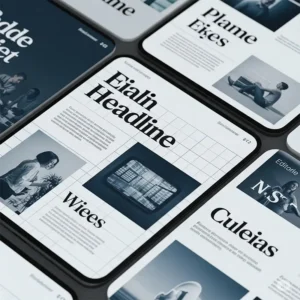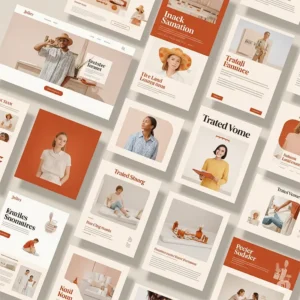Crafting Cohesive Digital Experiences
In the fast-evolving digital landscape, where content reigns supreme and attention spans are fleeting, the meticulous craft of editorial design is experiencing a profound renaissance. Far from being confined to the tangible pages of magazines and books, its principles are now vibrantly shaping digital platforms, creating immersive and unforgettable brand experiences. At TiP (Text in Process), we’re constantly exploring how the strategic application of editorial design not only reinforces a brand’s identity through consistent visual language but also replicates, and often enhances, the cherished print experience in the digital realm.
Editorial Design: More Than Just Layout
 Traditionally, editorial design has been synonymous with the thoughtful arrangement of text and imagery within a defined space, prioritizing readability, hierarchy, and aesthetic appeal. Think of the deliberate pacing of an article in a high-end magazine, the elegant interplay of typefaces, or the strategic placement of a stunning photograph to draw the reader in. These are not merely artistic choices; they are deliberate design decisions aimed at guiding the reader through a narrative, establishing a mood, and ultimately, communicating a message effectively.
Traditionally, editorial design has been synonymous with the thoughtful arrangement of text and imagery within a defined space, prioritizing readability, hierarchy, and aesthetic appeal. Think of the deliberate pacing of an article in a high-end magazine, the elegant interplay of typefaces, or the strategic placement of a stunning photograph to draw the reader in. These are not merely artistic choices; they are deliberate design decisions aimed at guiding the reader through a narrative, establishing a mood, and ultimately, communicating a message effectively.
However, in the digital age, this definition expands. Editorial design now encompasses the entire user journey, from the initial click to the final share. It’s about creating a cohesive, intuitive, and visually engaging experience across various devices and platforms. This is where its intrinsic link to branding becomes unequivocally clear.
Branding: The Visual Voice of an Identity
 A brand is more than just a logo or a catchy slogan; it’s a promise, an identity, and a set of values that resonate with its audience. Strong branding cultivates recognition, trust, and loyalty. Every touchpoint a user has with a brand – from its website and social media presence to its email newsletters and digital advertisements – contributes to their perception of that brand.
A brand is more than just a logo or a catchy slogan; it’s a promise, an identity, and a set of values that resonate with its audience. Strong branding cultivates recognition, trust, and loyalty. Every touchpoint a user has with a brand – from its website and social media presence to its email newsletters and digital advertisements – contributes to their perception of that brand.
This is precisely where editorial design becomes a powerful ally. When applied strategically, editorial design acts as the visual voice of a brand, ensuring that every piece of digital content reflects its core identity. Consistent use of brand colors, typography, imagery, and even whitespace across all digital assets reinforces the brand’s personality and professionalism. This consistency fosters familiarity and builds trust, making the brand instantly recognizable and memorable in a crowded digital space.
Replicating the Print Experience in the Digital Age
 One of the most fascinating developments we’re witnessing is how digital platforms are harnessing editorial design strategies to evoke the richness of the print experience. While the tactile sensation of turning a page remains unique, digital designers are employing sophisticated techniques to emulate the immersive qualities of print:
One of the most fascinating developments we’re witnessing is how digital platforms are harnessing editorial design strategies to evoke the richness of the print experience. While the tactile sensation of turning a page remains unique, digital designers are employing sophisticated techniques to emulate the immersive qualities of print:
- Thoughtful Typography: Beyond simply choosing readable fonts, digital editorial design leverages typography to establish hierarchy, convey tone, and enhance readability, much like in print. This includes careful consideration of line height, letter spacing, and character count to optimize the reading experience on screens of varying sizes.
- Grid Systems and Layouts: Just as in print, grid systems are fundamental in digital editorial design. They provide a structured framework for organizing content, ensuring visual balance, and guiding the user’s eye. Responsive grid systems adapt fluidly to different screen dimensions, maintaining aesthetic integrity across desktops, tablets, and smartphones.
- Rich Media Integration: Digital platforms offer an advantage over print in their ability to seamlessly integrate interactive elements. High-quality images, embedded videos, animated graphics, and interactive infographics can be strategically placed to enhance storytelling, mimicking the visual impact of a well-designed print spread while adding an extra layer of engagement.
- Pacing and Flow: Editorial design in print often dictates the pace at which a reader consumes content. Similarly, digital experiences are now designed with a clear sense of flow and narrative progression. This can involve strategic use of whitespace, scroll-triggered animations, and progressive loading of content to maintain user interest and guide them through a story.
- Personalization and Customization: While print offers a static experience, digital platforms can leverage data to personalize the editorial experience. This might involve recommending articles based on user preferences, tailoring content presentation to individual reading habits, or offering customizable viewing options, thereby enhancing engagement and relevance.
The Balancing Act: Tradition Meets Innovation
The challenge for designers today lies in harmonizing traditional editorial design principles with the dynamic capabilities of digital technology. This requires a delicate balancing act:
- Maintaining Readability on Diverse Screens: Adapting layouts and typography for optimal readability across a myriad of devices and screen sizes is paramount. This goes beyond simple responsiveness, delving into optimizing line length, font sizes, and contrast for different viewing environments.
- Navigating User Expectations: Digital users have evolved expectations. They demand instant gratification, intuitive navigation, and interactive experiences. Designers must incorporate these demands while retaining the thoughtful pacing and visual integrity that defines good editorial design.
- Leveraging Interactivity Without Overwhelm: The temptation to overdo interactive elements can detract from the core message. The key is to integrate interactivity thoughtfully, using it to enhance the narrative rather than distract from it.
- Ensuring Accessibility: Digital editorial design must be accessible to all users, including those with disabilities. This involves adhering to accessibility guidelines for color contrast, font choices, and navigation elements.
- Staying Current with Technology: The digital landscape is in constant flux. Designers must continuously update their skills and knowledge to leverage new technologies and platforms effectively while remaining grounded in the timeless principles of design.
TiP: Your Partner in Cohesive Digital Experiences
At TiP, we understand that strong editorial design is not a luxury, but a necessity for brands looking to make a lasting impact in the digital sphere. By blending our expertise in traditional publishing with a keen understanding of digital trends, we help our clients craft cohesive, engaging, and memorable digital experiences that reinforce their brand identity and resonate deeply with their audience. From meticulous typography and intuitive layouts to strategic use of interactive elements, we ensure that your digital content not only looks exceptional but also performs flawlessly, guiding your users through compelling narratives and strengthening your brand at every digital touchpoint.
